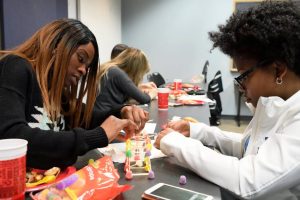
Designing and constructing a strong miniature bridge takes engineering acumen and plenty of strategy. But if the students who participated in the JHU chapter of the National Society of Black Engineers’ Bridge Building Contest are any example, it also takes substantial nutritional fortification.
“We’ve got plenty of pizza and wings, so help yourselves,” said Rayyan Gorashi, president of H.O.M.E.S (Hopkins Organization for Multicultural Engineers and Scientists) JHU’s NSBE chapter. Gorashi was welcoming students to the organization’s event, held on Thursday evening in the Mattin Center as part of Hopkins’ celebration of National Engineers Week.
At the event, five teams of two students loaded their plates and munched happily away as they competed to build the strongest possible 8-to-9-inch miniature bridges out of colorful, sugary gumdrops and wooden toothpicks in 30 minutes.
The models were then tested under progressively heavier loads of 45-gram alkaline batteries, calculators, cellphones, and a pouch of coins.
Meghna Kumar, a second year economics and sociology major, and Maya Foster, a second-year neuroscience major, competing as team “M & M,” took home the coveted $100 prize.
“The Bruddas,” a team comprising Rafael Ferguson and Justin Stith—both third-year environmental engineering majors—earned the second place spot.
Damali Egyen-Davis, a third-year biomedical engineering major, and Maia Watson, a third-year environmental engineering major, competing as the “Island Gyals,” took home third place.
Two teams tied for the fourth-place spot: Tiffany Hu, a third-year molecular and cell biology major, and Evelyn Yeh, a third-year biomedical engineering major, as “Team Pho”; and Anna Deberry, a fourth-year chemical and biomolecular engineering major, and Blossom Ogunyinka, a third-year public health studies major, calling themselves the “Wakanda Women.”
Gorashi said that though the event was lighthearted and fun, it also had other benefits.
“These kinds of activities are important because of the tangible aspect of them. You’re there with your bridge (in the case of this activity) from start to finish. And by the end of the activity, you’re able to see and physically touch that thing that you’ve constructed,” she explained. “For me, this tangibility was exactly what attracted me to the field of engineering. And by doing these kinds of activities with people not from the same background, it may spark an interest for them, too.”
For more photos of the event, visit the Johns Hopkins Engineering Facebook page.